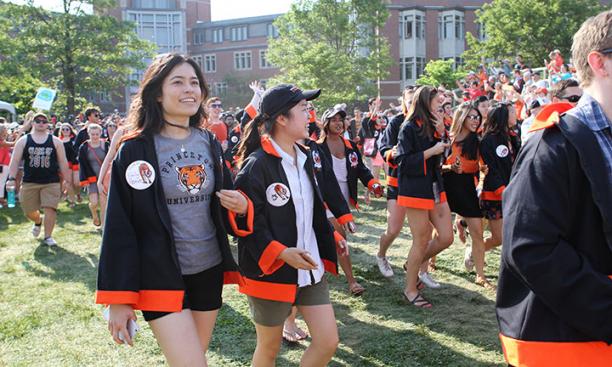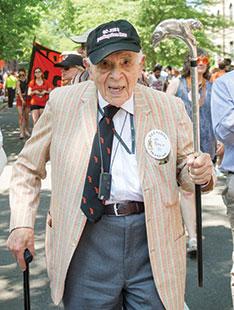Ah, this meeting brings back memories, childhood days. Lemonade! Romance!
My life was wrapped around the circus.
— J. Cheever Loophole, At the Circus, 1939
Every few years, we do a little deconstructing work here on the secret sauce of Reunions, that commonly named and uniquely operated exercise in suspension of disbelief to which almost every loyal Princetonian falls prey a few times over her lifespan. There are dozens of tiny touches, some of them wonderfully weird (this year’s Class of ’96 Ferris Bueller float comes to mind), some just Par-tay 101 (the Class of ’71’s Creedence Clearwater set), that get tossed into the cauldron each year to brew up (pardon the expression) yet another four-star Reunions extravaganza. However, the single thing that would bring the fabric of Reunions crashing down — the poles holding up the tent, if you will — is stunningly simple. If the senior class isn’t there, it’s not Reunions. Wildly counterintuitive as it may sound — how can you reune if you haven’t “uned” yet? — the newbies give everybody else, up to and including the Old Guard, an actual substantive reason to be, uh … reunion-ish on their day off.

It has always been so. Reunions at Princeton, formal or informal, have always included the seniors; reflecting a significant proportion of students who were Princeton legacies, the class gatherings began as accoutrements prior to Commencement in the early 19th century, and when Commencement moved, so did Reunions. The earliest vestiges of the P-rade involved the Yale baseball game on Commencement weekend (the older classes pulled rank and demanded the younger ones — and the students — march behind them so they could get the best seats). When Reunions accelerated after the Gilded Age, nobody ever thought seriously about changing the scheduling. After World War II, when the student body grew and the alumni body followed suit, everyone was having too good a time to worry about the logistic irrationality of the future numbers, now 25,000 or so and going nowhere but up.
Meanwhile, the P-rade, with the graduating class cheering every single alum in the procession, then in turn cartwheeling in their new beer jackets onto Poe Field and being welcomed into the august world of potential AG targets even before receiving their diplomas three days hence, has cemented them into the entire process beyond argument. I can honestly say that in 30 years of wandering around the morphing corridors of Old Nassau, I’ve never heard a single suggestion of altering Reunions’ basic schedule or composition. Other places bring the alumni back in mid-June or essentially lock out off-year classes, or spread things out over a few sessions or whatever. We sail blissfully onward, a tribute to humankind’s need to have a concrete outlet for wildly nutty concepts, especially now that the Marx Brothers are gone. Our own Room of Requirement, if you will.
Which is to say that Dr. William H. Vail 1865 would feel right at home at Reunions today. As a matter of fact, he could be a Reunions chair; he’s still a legend for his 50th in 1915. A physician living in Newark at the time, he celebrated at 70 years old by walking 50 miles from home to campus. That was a good warmup; by 1930 (remember, he’s 85 years old now), he and two of his classmates were the senior returning alumni at Reunions (one of them, Rev. Edward Payson Rankin, was the captain of Princeton’s first varsity team ever, the baseball team of 1864). Five years after that, The New York Times ran a feature on Vail as the oldest living auto driver in New Jersey. And two years after that, on June 19, 1937, now having been a member of the Old Guard for 22 years — it started at your 51st reunion in those days — Vail ambled along at age 92 as the oldest returning alumnus, walking the entire P-rade route all the way to University Field (where the E-Quad now resides).
But that’s just a small piece of the story between the Vails, Princeton, and, believe it or not, John Insley Blair, owner at one time of more American railroad track than anybody, philanthropist, and namesake of Blair Academy, Blairstown, N.J. (which he essentially created as his hometown in the middle of New Jersey’s woods), and of course, Princeton’s Blair Hall.
Dr. William Penn Vail, scion of an old New Jersey family and father of William H., went to work as Blair’s secretary in 1856, just as Blair’s son DeWitt Clinton Blair 1856 had his own Commencement. So William H. attended Blair Academy around the corner from Blair’s modest house in Blairstown, went through Princeton in three years, and received his degree on June 28, 1865; his senior oration topic was William the Silent, and he listened as President John Maclean 1816 read a letter of thanks for an in absentia honorary degree from President Abraham Lincoln, assassinated 10 weeks before. Vail earned his MD at Columbia in 1869, then was in practice in New York until 1886, when his father died and William H. succeeded him as Blair’s secretary. Blair became a Princeton trustee, and Vail engineered the donation of Blair Hall, the first great Gothic dorm, to the newly renamed University at the 1896 Sesquicentennial. Blair died in 1899, and Vail stayed on as secretary to his son DeWitt Clinton, who became a Princeton trustee in turn and expanded Blair Hall as well. Vail inherited a sizable sum from J.I. Blair, and donated much of it to build a great new library — not for Princeton, but for Lincoln University, the nation’s first college for black students, which had then been led for 34 years by Isaac Norton Rendell 1852 and generously supported by many other Princetonians in turn. Vail was a trustee of Lincoln for many years, and served on the board of Blair Academy for 50. An ardent Presbyterian, he never smoke or drank and, when he died in 1943 at 98 as the oldest living Princeton alumnus, attributed his longevity to brown: Brown eggs, brown sugar, whole wheat bread, and baked beans. And of course, walking.
And as he walked down 1879’s steps and down Prospect Avenue in the 1937 P-rade, he was cheered wildly by the senior class, not facing the happiest of times outside FitzRandolph Gate but at least knowing they had plenty of moral support. One of them was Joseph Schein ’37, another lifelong Jersey kid who had beaten long odds to get into Princeton and made the most of it. Son of Russian immigrants, an outstanding debater and athlete in high school — captain of the state-champion fencing team — he was neither a preppie, nor a legacy, nor a Protestant. But his own achievements and the track record of Newark’s Barringer High, which had turned out such notables as Jerome Kern, future Supreme Court Justice William Brennan, and Princeton’s legendary Moe Berg ’23, tipped the scales, and admission director Radcliffe Heermance admitted Schein as one of only 11 “Hebrews” in the Class of ’37. (Berg was Jewish as well.) Schein not only lettered in fencing but won honors with his thesis on Baudelaire in Modern Languages, receiving the Alden Prize as the best French language student in his class, and was active in the pre-med society, foreshadowing his vocation and following in Vail’s footsteps 72 years prior. And with the encouragement of Dean Christian Gauss, he organized and led some of the earliest Jewish services on the Princeton campus, which often included Albert Einstein.
From there Joe Schein got his MD at Penn, then moved to Mount Sinai in New York where he spent an astounding career of 70 years, beginning in pathology and transitioning to psychiatry, receiving his training from a colleague of Freud. A fellowship has been created in his honor there, and his bio includes the most literary statement by a physician I’ve ever seen: “Dr. Schein has always believed that there is no better training than the one originating from the 18th century by Giambattista Morgagni’s famous treatise De Sedibus Et Causis Morborum Per Anatomem Indagatis.” As if there were any question.
On May 28, 2016, Dr. Joe Schein ’37 p’74 p’76 received the Class of ’23 Cane at the Old Guard luncheon, and at 101 years old, 79 years after he watched Dr. Vail lead the P-rade behind the 25th Reunion class, Schein did it himself, also walking the entire P-Rade route as he has each year, despite 90-degree heat. Because the seniors are and were there as the crucial part of Reunions, he has been part of 152 years of Princeton’s history. It is well and good that we recall that history and discuss its import, but quite another thing altogether to have it smiling at us and giving a locomotive. It seems very much like magic, so much so that I suppose we can defer the debate of the relative medical merits of brown eggs and Morgagni until another time.
Dei sub numine viget.
With the journey of another great group of coach Lori Dauphiny women’s crews to Henley, we bid farewell to another academic year. Over the lonely weeks before our next foray in September, it’s a good time to revisit our various columns from the past year, perhaps join our new friends from the keen-eyed Class of 2020 in their Pre-read, and to get ready for a lively fall, which will include everything from new cushy turf on Powers Field to an election campaign that may be the oddest Federal government exercise since Big Block of Cheese Day. As Santayana would say, forewarned is forearmed!
Gregg Lange ’70 is the narrator of the P-rade at the reviewing stand. He is chair emeritus of the Alumni Council Committee on Reunions and a member of the Society of the Claw. In May he received the 2016 Thomas Foster Huntington ’42 P-rade Marshal Award.


